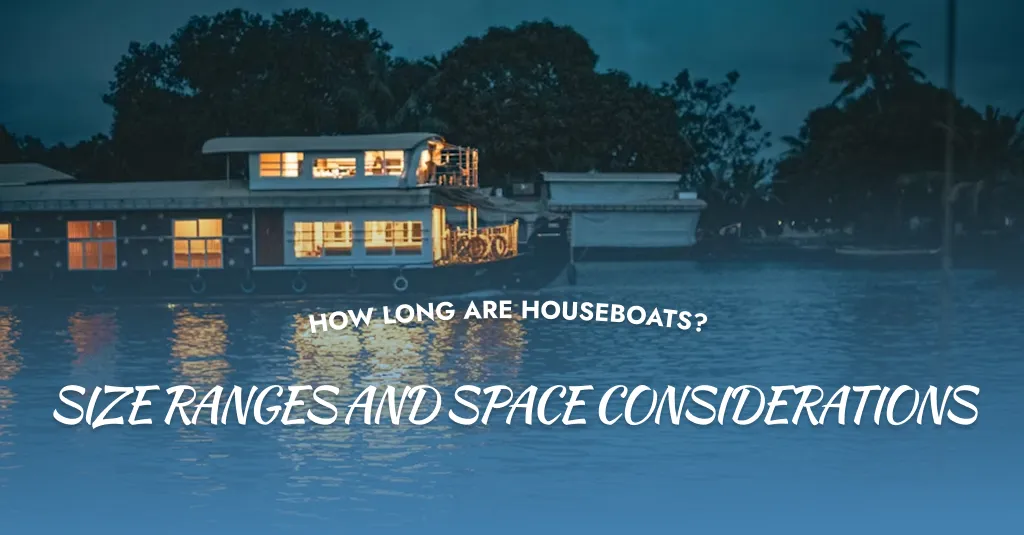
How Long Are Houseboats? Size Ranges and Space Considerations
The idea of living on a houseboat, with the Florida Keys’ turquoise waters as your backyard, is nothing short of magical. But one question often pops up for those considering this lifestyle: How long are houseboats, and how does their size impact living space and functionality?
This guide dives into houseboat size ranges, space considerations, and practical tips for choosing the right fit, drawing inspiration from Mangrove Marina in Tavernier. Houseboat sizes vary wildly, each offering unique benefits and challenges. Whether you’re dreaming of a compact retreat or a spacious floating home, let’s explore the dimensions of houseboat living.
Exploring Houseboat Size Ranges
Houseboats come in a spectrum of lengths, from cozy trailers to sprawling luxury vessels, each suited to different needs. Understanding their sizes helps you pick the perfect one for Florida’s waterways.
What Do People Ask About How Long Are Houseboats?
Folks often wonder about typical houseboat lengths and how they translate to livable space. Common questions include: What’s the best size for a couple, and how does length affect docking?
People frequently ask about standard sizes. Houseboats typically range from 20 to 120 feet, with most falling between 30 and 60 feet, offering 240-1,200 square feet of space. For couples, a 40-50 foot houseboat, like those docked at Mangrove Marina’s wet slips, provides ample room without overwhelming maintenance. The trailerable models (20-30 feet) fit easily in marinas like Mangrove’s boat ramp for quick launches.
Is There More to Know About How Long Houseboats Are?
Beyond basic lengths, houseboat size impacts stability, storage, and customization options. There’s more to uncover about how size shapes the liveaboard experience in Florida.
Houseboat length influences more than just space; it affects maneuverability and mooring costs. Larger houseboats (50+ feet) offer multi-deck layouts, adding up to 80% more space with two floors, but they’re harder to navigate in tight channels.
Smaller models, like pontoon houseboats, are ideal for inland waters and cost less to maintain, perfect for Mangrove Marina’s working yard services at $25/foot. Curious about customization? Longer houseboats allow for additions like rooftop terraces, enhancing the liveaboard lifestyle.
Houseboat Lifespan: Key Insights and Answers
Houseboat sizes tie into market trends and practical considerations like mooring and resale. FAQs often cover space planning and regional suitability.
Most houseboats listed on platforms like BoatTrader are 30-60 feet, with luxury models averaging 50 feet for 400-800 square feet. FAQs include: How does length affect cost? Each foot adds $2,000-$5,000 to the purchase price and $10-$20/month in slip fees.
Pontoon houseboats, as small as 20 feet, are popular for their stability in calm waters like those near Mangrove Marina’s fuel facilities. After a day on the water, unwind at Mangrove’s restaurant.
Space Considerations for Houseboat Living
Houseboat length directly shapes interior space, storage, and functionality, impacting daily life. Here’s how size translates to livable areas and what to consider.
A 40-foot houseboat typically offers 320-800 square feet, depending on decks and layout, suitable for a couple or small family. Multi-level designs maximize space, think lofts or rooftop lounges, but add weight, affecting stability in Florida’s coastal winds. Storage is tight, so vertical shelving and multi-purpose furniture are key.
For live boards, a 50-foot houseboat with two cabins and a galley feels like a condo, perfect for Mangrove Marina’s hurricane-hole basin. Smaller boats (20-30 feet) suit weekenders but may feel cramped for long-term use.
Choosing the Right Houseboat Size
Picking the ideal houseboat length balances lifestyle, budget, and location. These considerations ensure your vessel fits your Florida adventures.
Lifestyle Needs
Couples or solo travelers thrive in 30-40 foot houseboats; families need 50+ feet for extra cabins.
Budget
Smaller houseboats cost $50,000-$100,000, while luxury models hit $500,000. Slip fees at Mangrove Marina range from $500-$1,000/month.
Maneuverability
Shorter houseboats are easier to handle in tight marinas like Mangrove’s wet slips.
Storage
Larger boats offer more room but require Mangrove’s dry racks for off-season protection.
Test It Out
Try Mangrove Marina’s houseboat lodging to gauge space needs before buying.
Maintenance and Space Optimization Tips
Houseboat length impacts maintenance and livability, especially in Florida’s salty environment. These tips maximize space and keep your vessel in top shape.
Regular hull cleaning prevents corrosion, extending houseboat lifespan. Use Mangrove Marina’s working yard for professional care. Optimize space with foldable furniture and built-in storage; a 40-foot houseboat can feel spacious with smart design.
Protect against UV damage with covers, especially for larger decks, and store off-season at Mangrove’s dry racks. For fuel efficiency, smaller houseboats use less gas, easily refueled at Mangrove’s fuel facilities. Regular inspections catch issues early, preserving space and structure.
Navigating Houseboat Life in Florida
Houseboat length shapes your experience, from cozy retreats to expansive homes, offering freedom in Florida’s stunning waterways. Whether you choose a compact 20-footer or a 60-foot luxury vessel, understanding size ranges and space considerations ensures a perfect fit. With Mangrove Marina’s amenities, like the pool and bathhouse, your houseboat life blends adventure and comfort.
Ready to float into this lifestyle? Visit Mangrove Marina in Tavernier to explore houseboat lodging, docking, and more. Book your stay today and find your ideal houseboat size!
FAQs
What’s the smallest houseboat size for liveaboard life?
20-30 foot houseboats (160-240 sq ft) work for solo or couple liveaboards, though storage is limited.
How does houseboat length affect insurance costs?
Longer houseboats (50+ feet) cost more to insure, averaging $800-$1,500/year due to higher value and risk.
Are larger houseboats harder to maintain?
Yes, larger houseboats require more frequent hull cleaning and engine checks, increasing maintenance costs by 20-30%.
Can houseboat size impact resale value?
Mid-sized houseboats (30-50 feet) often sell faster due to broader appeal and lower mooring fees.
What’s the best houseboat size for Florida’s waters?
30-50 feet suits inland and coastal waters, balancing space and maneuverability for Keys cruising.





